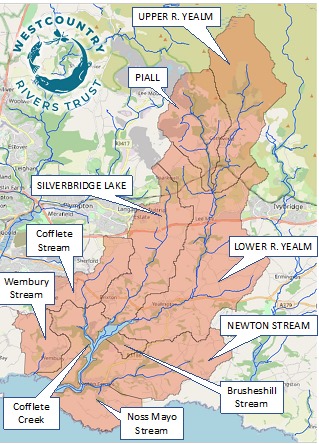
The river Yealm runs for twelve and a half miles from Yealm Head on Dartmoor to the sea at Noss Mayo large sections of which have a magical beauty. However, communities living beside the river are increasingly concerned that it is in trouble and the catchment is losing it’s biodiversity.
The river Yealm does have many wooded areas along its length, providing important habitats for wildlife and reference lines and roosting places for bats and birds, as well as protection for mammals large and small. These woodlands, some of them ancient woodland, are important wildlife corridors but they have become increasingly fragmented with connectivity of these habitats affected by roads, fences, walls and buildings.
Sadly, the River Yealm itself is all too frequently polluted by outflows and run-offs resulting from human activity or extreme weather events. There are now very few fish in the river, the oyster fishery has closed down and swimming is currently not recommended due to the presence of harmful bacteria and other pollutants.
This pattern is repeated on a national and international scale, as reflected in our own dramatic loss of wildlife according to successive “State of Nature” reports from invertebrates to keystone species at the top of the food chain. For example, only 3% of the wildflower meadows from the 1970s still exist and insect numbers have declined by 41% which threatens the whole hierarchy of wildlife up the food chain from those that pollinate our food, to mammals, fish, amphibians, bats, birds and raptors. This is largely due to loss of habitat.
As David Attenborough states in Life on Our Planet”, “we need to work with nature not against it”

Yealm Estuary to Moor (YEM) is aimed at improving both the health of the River Yealm and management of the land and river in favour of the naturally occurring flora and fauna. The objective is a long term one to create a wildlife corridor within the River Yealm catchment from its source on Dartmoor to the estuary at Wembury by connecting up and re-storing and joining fragmented habitats.
This project is being brought to life by a co-operative community group of volunteers supervised by professional organisations who have the necessary experts, such as ecologists and farming liaison officers. We are working Southwest Rivers Trust (WRT) who have river management skills and YEM has been pledged support from both Dartmoor Parker’s Authority and and South Devon AONB covering both ends of the catchment. Together with our volunteers and partners we aim to get it right, do no harm and leave a sustainable legacy with lasting benefit for the communities involved.
The Westcountry Rivers trust (WRT) has carried out an extensive Scoping Study as well as training of volunteers in water sampling and monitoring. The necessary funds for this have been raised by YEM, including from the riparian Parish Councils who have been concerned about deteriorating river water quality. Data from this Citizen Science Investigation will be analysed by the WRT, and shared with both the relevant Parish Councils and the Environment Agency, which has had its budget severely cut over the last decade.
We have also secured funding for a post graduate intern from the University of Plymouth to carry out a Feasibility Study to help identify suitable sites for pilot studies. The Internship finished at the beginning of September 2022 and we will be using the report findings to direct our next steps. This will be assisted by a very experienced person from Devon Wildlife Trust who will be working with us from October.
If you would like to be part of this exciting project and volunteer please provide your detailson the “Support Us” page of this website.
